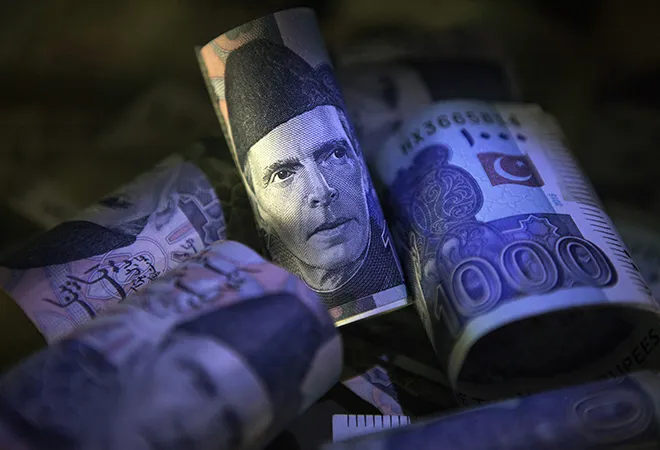
Is Pakistan, as it is currently structured, an economically viable state? Is it a state that can sustain itself without huge amounts of foreign assistance? In other words, can Pakistan live off its own money or does it survive on other people’s money?
The economic crisis that the country is facing is not new. In fact, it is cyclical and every few years, Pakistan finds itself in a similar crisis. But every new cycle brings Pakistan closer to the point of an economic meltdown. The current economic crisis is in many ways far worse than earlier crises that the country has faced. Not only is this financial, it is systemic and structural. Band-aid solutions might delay the inevitable, but won’t address the fundamental problems that bog the economy. If anything, the bailouts being given will only pull Pakistan out of the immediate crisis, but then create the conditions for the next upcoming crises, which will be even more difficult to handle. This is in part because the sweeping reforms that need to accompany the bailouts will either be done half-heartedly, or else partially and extremely reluctantly, not with the purpose of reform but to ward off the immediate crisis. Against this backdrop, when the de facto finance minister, who has been imported and imposed upon the government allegedly by the IMF and the Pakistani ‘deep state’ says that unless the country addresses the imbalances in the economy, it is heading for a default and will be left with no escape route, it is a sign that things are actually even worse than what they appear to be.
If the latest Pakistani budget is anything to go by, the economy seems to be entering a long dark tunnel with no light coming in from the other side. The numbers in the budget are so far-fetched that no one is really taking them seriously. What is worse, even if Pakistan actually manages to achieve the numbers it has given in the budget 2019-20, it doesn’t really pull the country out of the economic morass in which it finds itself. The reason is simple: the financials of Pakistan are totally out of sync with the fundamentals of economic management. Their sums don’t match, and the way they are making their national accounts books match smack more of voodoo economics than anything else.
If the latest Pakistani budget is anything to go by, the economy seems to be entering a long dark tunnel with no light coming in from the other side. The numbers in the budget are so far-fetched that no one is really taking them seriously.
According to the 2019-20 budget, the federal government proposes to collect taxes of PKR 5.55 trillion. This is an increase of PKR 1.450 trillion (approximately 35%) over the revised tax collection of PKR 4.150 trillion in the outgoing fiscal year. The revised tax number is also inflated and is not expected to cross PKR 3.95 trillion when the financial year closes on 30 June. The ‘revised’ tax collection is PKR 285 billion less than the budgeted tax collection for FY 2018-19 and the expected number is PKR 485 billion less than budgeted number. The real kicker is that even the inflated revised tax collection number for FY 2018-19 is almost the same as the revised number for the FY 2017-18 (pg. 3). In other words, the total tax collection was virtually static in the outgoing year. And yet, there is the projection of a nearly 35% increase (40% if the expected or if you will, the actual number of PKR 3.95 trillion is considered) in tax collections in the budget for 2019-20!
In 2018-19, given the GDP growth of 3.3% (according to independent economists, even this GDP growth of 3.3% has been jacked up by almost 1% by showing an increase in electricity generation & distribution and gas distribution sector growing by an unbelievable 40%) and an inflation of around 7%, tax collections should have risen by around 10-11% at the very least. But this didn’t happen. In the next fiscal, with growth expected to contract further to 2.4% and inflation expected to be around 11-13%, the tax collections could increase by around 15% in the natural course. But to expect them to increase by 35% (or 40% if the actual number is taken into account) is utterly unrealistic. The only possible justification for fixing such an over-ambitious tax revenue target is a World Bank report which has calculated that Pakistan can raise substantial tax revenues by improving compliance, removing exemptions and broadening and expanding the tax base. Although the World Bank has agreed to fund the revenue mobilisation project, the last time such a project was funded by the World Bank, produced less than satisfactory results.
Given that Pakistan’s population is growing at 2.4% every year, if the GDP growth in the outgoing and the coming year is going to be more or less the same, it means that there is virtually no growth in incomes. Add to this rising inflation (independent economists calculate that because of rising taxes, weakening of the Pakistani rupee and a massive spike in utility prices, inflation will be at least a few percentage points higher than the 11-13% estimated by the Pakistan government), it means that poverty levels will rise as will unemployment. The above is the best case scenario in which the government is able to achieve the targets it has set for itself in the budget.
Given that Pakistan’s population is growing at 2.4% every year, if the GDP growth in the outgoing and the coming year is going to be more or less the same, it means that there is virtually no growth in incomes.
Even if Pakistan pulls off the impossible and meets the revenue target of PKR 5.55 trillion, it doesn’t take the country out of the woods. The reason is that its fiscal math is totally out of sync. The net revenue receipts that the federal government estimates is only PKR 3.46 trillion. But just debt servicing (PKR 2.89 trillion) and defence expenditure (PKR 1.15 trillion) are PKR 500 billion more than the grossly over-optimistic estimate of revenue that the government of Pakistan hopes to collect. In other words, everything else that the government does is on borrowed money. In fact, the net revenue is only 50% of the PKR 7.02 trillion total federal expenditure that the government will incur.
According to the government’s own calculations, the total fiscal deficit in 2019-20 will be 7.2% of GDP, almost the same as the fiscal deficit number given for the outgoing financial year. But the thing is that given the inflated revenue numbers for 2018-19, it is expected that the fiscal deficit will be closer to 8%. Next year, it could be 9% or even more depending on how much the revenue shortfall is. Already, economists are claiming that the PKR 423 billion of provincial surpluses that the federal government is expecting are unlikely and this alone means that the fiscal deficit will breach the 8% mark. And if there are cost escalations in defence spending or if interest rates rise further and the rupee weakens more (by some estimates the Rupee could fall to 180 to a Dollar by December, and may even breach the 200 mark) then debt servicing will shoot up further and make an even bigger hole in the budget. Even if the pessimists are proven wrong, and everything works according to plan, Pakistan’s total public debt will continue to gallop out of control. Since the ouster of the military dictator Gen Pervez Musharraf, Pakistan’s debt has almost doubled every five years, and given the trajectory of borrowings done by the Imran Khan government in the last 10 months, Pakistan’s debt could double again by the time the current dispensation completes its term.
Clearly, this is an unsustainable proposition and Pakistan is staring at a sovereign default. Economists have been warning of the country being caught in a debt-trap situation for some years, but it is now that the imminence of the crisis has hit home. After the usual bluff, bluster and bravado, which has become the hallmark of Pakistan in general and the Imran Khan led dispensation in particular, Pakistan has been forced to approach the IMF for a bailout. Before approaching the IMF, however, Imran Khan went hat in hand to ‘friendly countries,’ hoping that this would help Pakistan avoid the tough conditions that the IMF was expected to impose before agreeing to a bailout. But within a few months Pakistan had run through the over USD 9 billion that it borrowed from Saudi Arabia, UAE and China. The last resort left was the IMF.
After the usual bluff, bluster and bravado, which has become the hallmark of Pakistan in general and the Imran Khan led dispensation in particular, Pakistan has been forced to approach the IMF for a bailout.
Much of the budget seems to be aimed at only getting the IMF package, which in turn will open to doors to other multilateral funding and also the access to international financial markets. But the unrealistic numbers in the budget suggest that Pakistan will in all likelihood live up to its infamy as a ‘one tranche nation.’ In the last 60 years, Pakistan has gone to the IMF 21 times. The latest IMF programme that Pakistan is entering will be the 22nd time. Out of all these programmes, the only time Pakistan successfully completed an IMF programme was the 2013 one, and even that after the Fund allowed more than a dozen waivers on non-observance of performance criteria on the basis of which the programme had been approved. What this means is that Pakistan has never carried out the structural reforms that the IMF had recommended. As a result, on an average every 3-4 years Pakistan has had to go hat in hand to the IMF. Over the years, two things have happened. One, the US romance with Pakistan has ended and the soft terms, concessions, bailouts and waivers that came by so easily in the past are no longer available; two, the IMF has also smartened up to Pakistan’s shenanigans and has insisted on front-loading the conditionalities instead of spacing them out. Pakistan invariably used to take the IMF for a royal ride by taking the money and then reneging on the conditionalities. The IMF therefore has forced Pakistan to take ‘prior actions’ before it even approves the Extended Fund Facility arrangement.
For now, Pakistan is banking upon its time tested modus operandi of tiding over the immediate crisis by giving in to whatever is demanded of it, and then waiting and hoping that things take a turn for the better so that they no longer need to deliver on the commitments they have made. The way the Pakistanis see it, their ‘geography for alms’ strategy has never failed them in the past. In the region they are located, something or the other always happens that opens the floodgates of funds for them. Who knows? Perhaps, the Americans will once again rediscover Pakistan’s utility as a mercenary state? Maybe, the Chinese will become more expansive in pouring in funds? What’s to rule out the Saudis or UAE opening their coffers in exchange for some Pakistani troops deploying in the Middle East to fight the dirty wars being fought there? And, if all else fails, Pakistan can always leverage itself as “a country too dangerous to fail.” But if nothing works, and no one is ready to throw good money after bad in Pakistan, then it will be exceedingly difficult to prevent an economic meltdown.
The views expressed above belong to the author(s). ORF research and analyses now available on Telegram! Click here to access our curated content — blogs, longforms and interviews.




 PREV
PREV


